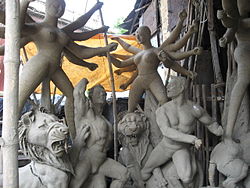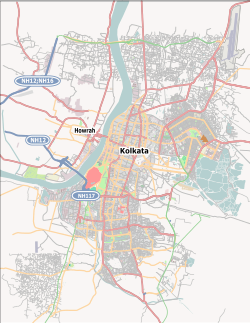Kumortuli
| Kumartuli | |
|---|---|
| Neighbourhood in Kolkata (Calcutta) | |

Clay images under preparation at Kumartuli
|
|
| Location in Kolkata | |
| Coordinates: 22°36′00″N 88°21′41″E / 22.6000°N 88.3614°ECoordinates: 22°36′00″N 88°21′41″E / 22.6000°N 88.3614°E | |
| Country |
|
| State | West Bengal |
| City | Kolkata |
| Ward |
|
| Metro Station | Shobhabazar-Sutanuti |
| Elevation | 36 ft (11 m) |
| Time zone | IST (UTC+5:30) |
| Area code(s) | +91 33 |
Kumortuli (also spelt Kumartuli, or the archaic spelling Coomartolly) is a traditional potters’ quarter in northern Kolkata (previously known as Calcutta), the capital of the east Indian state of West Bengal. The city is famous as a sculpting hot-spot which not only manufactures clay idols for various festivals but also regularly exports them.
The British colonisation of Bengal and India started following the victory of the British East India Company in the Battle of Plassey in 1757. The Company decided to build new settlement Fort William at the site of the Gobindapur village. Most of the existing population shifted to Sutanuti. While such neighbourhoods as Jorasanko and Pathuriaghata became the centres of the local rich, there were other areas that were developed simultaneously. The villages of Gobindapur, Sutanuti and Kalikata developed to give rise to the later day metropolis of Calcutta.
Holwell, under orders from the Directors of the British East India Company, allotted ‘separate districts to the Company’s workmen.’ These neighbourhoods in the heart of the Indian quarters acquired the work-related names – Suriparah (the place of wine sellers), Collotollah (the place of oil men), Chuttarparah (the place of carpenters), Aheeritollah (cowherd’s quarters), Coomartolly (potters’ quarters) and so on.
Most of the artisans living in the north Kolkata neighbourhoods dwindled in numbers or even vanished, as they were pushed out of the area in the late nineteenth century by the invasion from Burrabazar. In addition, Marwari businessmen virtually flushed out others from many north Kolkata localities. The potters of Kumortuli, who fashioned the clay from the river beside their home into pots to be sold at Sutanuti Bazar (later Burrabazar), managed to survive in the area. Gradually they took to making the images of gods and goddesses, worshipped in large numbers in the mansions all around and later at community pujas in the city and beyond.
...
Wikipedia

